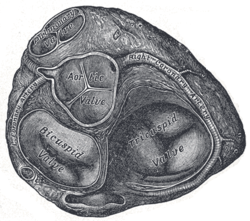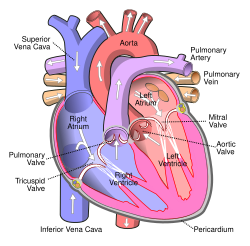Mitral valve
| Mitral valve | |
|---|---|
|
Anterior (frontal) view of the opened heart. White arrows indicate normal blood flow. (Mitral valve labeled at center right.)
|
|

Base of ventricles exposed by removal of the atria. (Bicuspid (mitral) valve visible at bottom left.)
|
|
| Details | |
| Identifiers | |
| Latin | Valva atrioventricularis sinistra, valva mitralis, valvula bicuspidalis |
| MeSH | A07.541.510.507 |
| Dorlands /Elsevier |
12843904 |
| TA | A12.1.04.003 |
| FMA | 7235 |
|
Anatomical terminology
[]
|
|
The mitral valve, also known as the bicuspid valve or left atrioventricular valve, is a dual-flap valve in the heart that lies between the left atrium and the left ventricle. The mitral valve (not to be confused with the congenital bicuspid aortic valve) and the tricuspid valve are known collectively as the atrioventricular valves because they lie between the atria and the ventricles of the heart and control the flow of blood.
During diastole, a normally-functioning mitral valve opens as a result of increased pressure from the left atrium as it fills with blood (preloading). As atrial pressure increases above that of the left ventricle, the mitral valve opens. Opening facilitates the passive flow of blood into the left ventricle. Diastole ends with atrial contraction, which ejects the final 20% of blood that is transferred from the left atrium to the left ventricle. This amount of blood is known as end-diastolic volume, and the mitral valve closes at the end of atrial contraction to prevent a reversal of blood flow.
The mitral valve is typically 4–6 cm² in area. It has two cusps, or leaflets (the anteromedial leaflet and the posterolateral leaflet), that guard the opening. The opening is surrounded by a fibrous ring known as the mitral valve annulus. (The orientation of the two leaflets resembles a bishop's mitre, whence the valve receives its name.) The anterior cusp protects approximately two-thirds of the valve (imagine a crescent moon within the circle, where the crescent represents the posterior cusp). Although the anterior leaflet takes up a larger part of the ring and rises higher, the posterior leaflet has a larger surface area. These valve leaflets are prevented from prolapsing into the left atrium by the action of chordae tendineae, the tendons attached to the posterior surface of the valve.
...
Wikipedia


